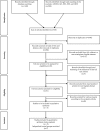Clinical effectiveness of chin cup treatment for the management of Class III malocclusion in pre-pubertal patients: a systematic review and meta-analysis
- PMID: 25679781
- PMCID: PMC4250531
- DOI: 10.1186/s40510-014-0062-9
Clinical effectiveness of chin cup treatment for the management of Class III malocclusion in pre-pubertal patients: a systematic review and meta-analysis
Abstract
Background: Chin cup is regarded as the oldest orthodontic appliance for the management of Class III malocclusion. To assess its clinical effectiveness in pre-pubertal patients, a meta-analysis on specific cephalometric values is attempted.
Methods: Detailed electronic and hand searches with no restrictions were performed up to July 2014. Only randomized controlled trials (RCTs) and cohort studies, i.e. prospective controlled trials (pCCTs) and (retrospective) observational studies (OS), were included. Analyses were performed by calculating the standard difference in means and the corresponding 95% confidence intervals, using the random effects model. Data heterogeneity and risk of bias assessment of the included studies were also performed. Study selection, data extraction and risk of bias assessment were performed twice. The level of significance was set at P ≤ 0.05 for all tests, except for heterogeneity (P ≤ 0.1).
Results: Seven treated groups from five studies (no RCTs, four pCCTs, one OS) were eligible for inclusion, assessing only the short-term occipital pull chin cup effects. In total, 120 treated patients (mean age: 8.5 to 11 years) compared with 64 untreated individuals (mean age: 7.3 to 9.89 years) were assessed by means of 13 cephalometric variables. The overall quality of these studies was low to medium. In comparison to untreated individuals, the SNB and gonial angles decreased significantly following chin cup use, whereas ANB, Wits appraisal, SN-ML, N-Me and overjet increased. For the rest of the variables, no statistically significant differences were detected.
Conclusions: Although the occipital chin cup affects significantly a number of skeletal and dentoalveolar cephalometric variables, indicating an overall positive effect for the treatment of Class III malocclusion, data heterogeneity and between-studies variance impose precaution in the interpretation of the results.
Figures















References
-
- Alexander KN. Genetic and phenotypic evaluation of the class III dentofacial deformity: comparisons of three populations [Dissertation]. Chapel Hill (USA): University of North Carolina at Chapel Hill; 2007.
-
- McNamara JA. Treatment of patients in the mixed dentition. In: Graber TM, Vanarsdall RL, Vig KWL, editors. Orthodontics: Current Principles and Techniques. China: CV Mosby; 2005. pp. 543–77.
-
- Ngan P. Treatment of Class III malocclusion in the primary and mixed dentitions. In: Bishara ES, editor. Textbook of Orthodontics. US: Saunders; 2001. pp. 375–414.
-
- Proffit WR, Fields HW. Contemporary Orthodontics. 3. US: CV Mosby; 2000.
Publication types
MeSH terms
LinkOut - more resources
Full Text Sources
Other Literature Sources
Medical

